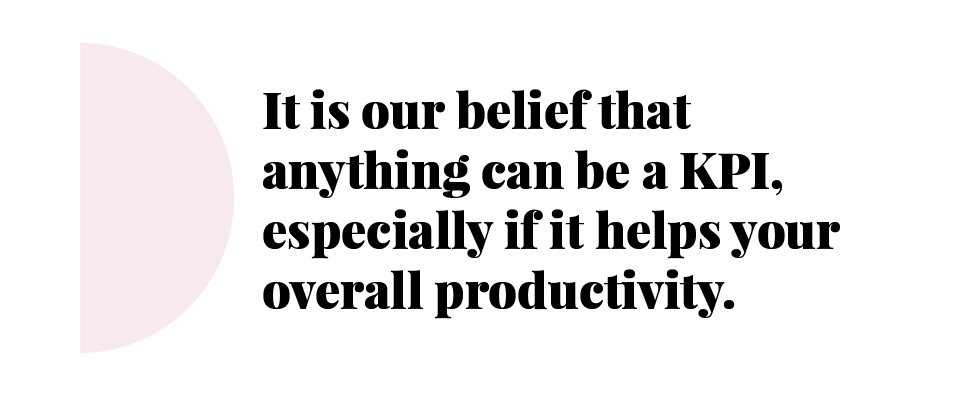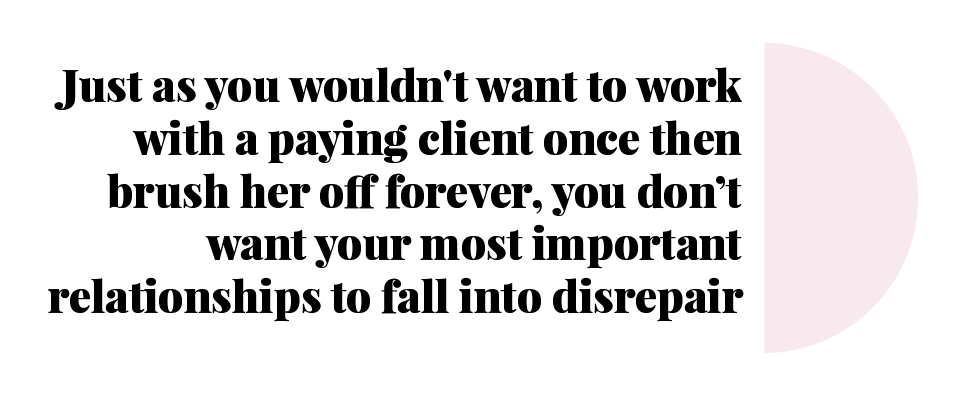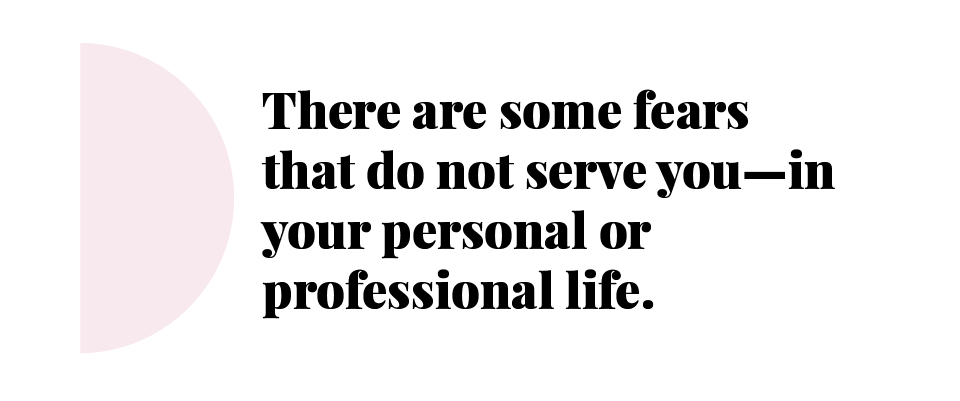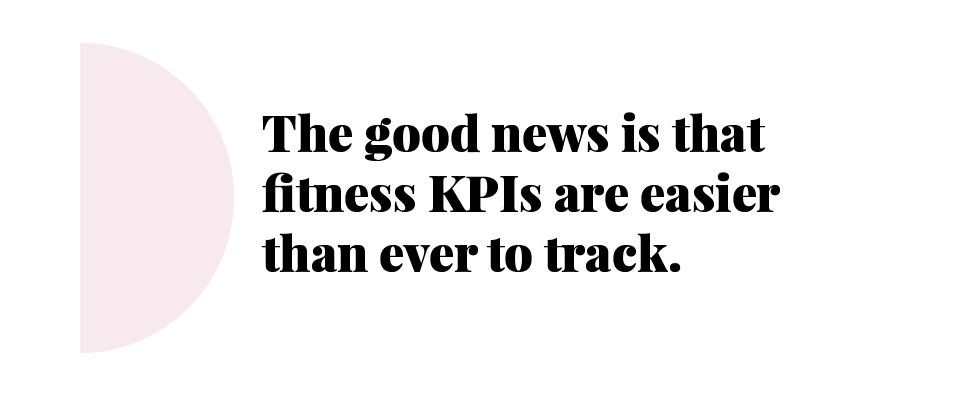KPIs—they’re not just for work anymore.
Whether you’re
starting a brand new job, transitioning into a new position within your current company, preparing to start a new project with colleagues, or you’re looking to set aggressive personal growth goals for yourself, setting personal KPIs is key (no pun intended).
Even if you’re stellar at your job—in marketing, social media, customer service, or graphic design—it’s important to set and keep track of goals. Why? For many reasons.
Setting goals, both achievable and more grandiose, will keep you motivated and accountable—on a daily basis.
And, as we said, KPIs aren’t just for work. If you are struggling with to-do lists piling up at home thanks to your lack of time management skills, relationships that haven’t been nurtured in your personal life, or mounting health issues that are impacting your capabilities, it’s important to set KPIs around these things. Since KPIs use metrics to measure change and growth, they can motivate the parts of your life that need some extra TLC.
Table of Contents
Let’s dive into the setting (and surpassing!) your own key performance indicators—in your personal and professional life. We'll also share lots of examples of personal development goals you can consider for all areas of your life!
What Are KPIs or Key Performance Indicators?
KPI stands for Key Performance Indicator. Typically used in a business setting,
KPIs are measurable values that track and indicate performance. At the business level, you have two kinds of KPIs: high-level and low-level.
High-Level KPIs
High-level key performance indicators include (you guessed it!) more overarching goals, or organizational objectives, like the overall performance of a company. They might help measure employee satisfaction or employee performance on a general level.
Low-Level KPIs
Lower-level KPIs are more departmentally based, such as performance around marketing, sales, and customer support. These KPIs measure conversion rates or numbers of qualified leads, for example. Your team leader likely uses these to guide the team toward smaller, more specific goals. A lower-level KPI might also be a short-term goal.
Every KPI is only as effective as the motivation it sets into motion. Setting KPIs with a sensible, achievable, and valuable goal is crucial. They should stand up to
a thorough evaluation after the actions toward them have been taken. For example, to set a KPI that your company will make $1 million in revenue—without any context or plans—is not a plan.
Instead, KPIs should be laser-focused on how you will achieve this. If your company or boss aims to earn $1 million, what does that mean in terms of generating site traffic? How will marketing team members contribute to this goal? How does your sales team translate marketing efforts into real dollars? Are all your coworkers in alignment on how these accomplishments will happen?
It’s important to make both high-level and low-level KPIs. If all of your lower-level key performance indicators can work together to reach the ultimate high-level goal, you have a great accountability system in place.
How Do I Define My Own KPIs?
In the workforce, career goals and directives can get muddled in an unnecessary amount of
complicated jargon. Let’s remove all of that to set some real KPIs.
Setting your first KPI, whether personal or professional, means running it through a couple of filters. Ask yourself these questions before implementing them. They're sort of a KPI formula if you will.
- What is my desired goal?
- Why does this goal matter?
- How long will this goal take?
- What metrics am I using to measure my progress toward the goal?
- How often am I measuring progress?
- How will I know when I have reached my desired goal?
Here’s an example of a personal KPI you could set to learn a new skill at work.
- What is my desired goal? My goal is to learn how to create Excel spreadsheets.
- Why does this goal matter? Having a deep knowledge of organizing data in Excel will make me a more proficient marketer—and help me disseminate important data points for my team.
- How long will this goal take? The course takes six hours to complete and I will break it up over four weeks.
- What metrics am I using to measure my progress towards the goal? I am taking an online course to learn different aspects of using Excel.
- How often am I measuring my progress? I am spreading the course over four weeks and measuring my learnings on a weekly basis.
- How will I know when I reached my desired goal? I will have the knowledge base to organize an entire year of data into a digestible report. I will present to my manager.
Use this line of questioning whenever you set a goal for yourself. Some goals will be more open-ended in regards to time spent, outcome, or progress. If you can answer each of these questions at the start, you're already well on your way to achieving whatever strategic goals you are after.
In addition to asking these questions, you will want to ensure that
your KPIs are SMART. By running your KPIs through a SMART goals template, you can keep track of the relevant data points throughout the process. Your SMART KPI will be:
- Specific
- Measurable
- Attainable
- Relevant
- Time-Bound
We've divided these KPI categories into sections that reach beyond the workplace. Let’s set some KPIs!
How to Create KPIs for Your Home Life
We are all guilty of letting a few home things slide. We might have a stack of bills sitting on our kitchen table with a post-it reading “Do Not Touch!” and we promise we will get to it sooner or later. Weeks later, this three-inch pile has turned into a table full of unopened mail.
Your at-home KPI can be as simple as devoting a specific amount of time to organizing at—home tasks or as overarching as scheduling daily home check-ins to conquer tasks. Use them to set the specific organizational goals that will benefit you the most.
If you’re skeptically reading this (hi!), you might argue that getting your laundry done on a Tuesday isn’t—and can never be—a KPI. To that, we say: boo! We believe that KPI use can work for just about anything, especially if it
helps your overall productivity or improves upon
a certain habit or behavior.
In short, KPIs are resources that can be applied to various organizational tasks (yes, even to laundry).
If you want to be extra diligent, you can keep track of how much time is being spent on different tasks, where certain chores can be delegated to other people, and how to consolidate several tasks into one dedicated time period.
Self-awareness like this can not only be helpful for your overall self-development but keeping a journal that tracks your tasks and the time they can take is one of the most popular pieces of advice from
time management experts like Laura Vanderkam.
How to Create Relationship KPIs
When you first befriend someone, or when you’re first starting to date someone, you likely put in a lot of work. You
schedule time to grab a coffee, you have discussions about your dreams and fears, and you likely spend time analyzing the relationship.
Where is this relationship going? What is the desired outcome here? How does it serve me and my bigger life goals? What are we both getting out of this? Is this worth my time?
After a while, as with any relationship, less work is done to nurture and maintain the bond. As a result, some friendships fizzle off, some relationships slowly putter out, and others experience rocky patches.
It’s important, especially with your more valuable relationships, to give more consideration. Just as you wouldn't want to work with a paying client once then brush her off forever, you don’t want your most important relationships to fall into disrepair.
How to Create Fear-Based KPIs
Are there certain things that scare you right down to your core? These might be the most important KPIs to set, because they're the ones likely holding you back.
Maybe it’s time to conquer a few fears or break a bad habit. No, you don’t have to submerge yourself in a bathtub full of snakes. However, there are some fears that do not serve you—in your personal or professional life.
Some fears worth setting a KPI toward could include:
You can set KPIs to attack any of these fears. Use data-based steps to face these fears head-on. If you are looking to overcome your fear of public speaking, you can take small, trackable steps to conquer it. Let’s go through them together.
- What is my desired goal? To overcome my fear of public speaking.
- Why does this goal matter? Overcoming my fear of public speaking will open me to new career opportunities, allow me to share my ideas in a public forum, and will open me up to leadership roles in the future. (Specific + Relevant)
- How long will this goal take? I want to take the next three months to take real steps to conquer my fear. (Time-Based)
- What metrics am I using to measure my progress towards the goal? Every work week, I will explore new ways to speak publicly. I can take a meeting with my team to kickstart some new ideas. I can create a web-based webinar to share my skills. I can take an online course on public speaking. (Attainable)
- How often am I measuring progress? On a weekly basis. My goal is to make one leap per week over the course of three months. (Measurable)
- How will I know when I reached my desired goal? I will have reached my desired goals when I feel confident and maybe even excited to speak publicly. (Specific)

How to Create Budgeting KPIs
We have to talk about money. When you’re not paying attention—buying that coffee, skipping that gym class (and incurring that $15 cancel fee), and taking Lyfts everywhere—expenses can really add up.
Your budget can go out of the window.
Setting budgeting KPIs is the first step toward
personal financial success. A word to the wise—taking money steps isn't always easy. But, you don’t need to set out with the goal to save $5,000 in one month. Instead,
set smaller, more achievable goals. If you spent $300 on coffee last month, try to reduce that budget by $200. Make coffee at home. Invest in a portable coffee cup.
How to Create a Personal Budget
Your personal budget could be a great place for a high-level KPI, too. A great place to start is by looking through your salary and monthly income against last month’s total spending. Separate your expenses into your musts (rent, insurance, food, gas), your nice-to-haves (meals out, gym membership, clothing), and your less wise choices (constant meals out, expensive cocktails, too much shopping).
From here, cross out what you could have gone without. This doesn’t mean you can’t have any fun or eat out with friends; rather, it means you'll be clearer in your decision-making around your budget. Some good KPIs you can set around budgeting are:
- Spending X less in a given month
- Saving X amount in a given month
- Spending less on X in a given month
- Saving to buy X by a certain date
How to Create Fitness KPIs
The good news is that tracking KPIs for fitness is easier than ever. There are countless apps and devices to help you to keep track of your steps, heart rate, and water intake—you name it, and they can track it.
Some goals you can set are:
- Mileage per day
- Steps per day
- Steps per week
- Active minutes per week
- Working towards a race
- Gym classes per week
- Dance classes per week
How to Create Anti-Burnout KPIs
This one is worth adding because, sometimes, we need to
give ourselves a break. Life can get ahead of us at times. If we aren’t paying attention, we could go a full year without taking a long weekend to just relax, read a book, and eat a whole cheesecake in one sitting.
No, we don’t think your “chilling out” KPI should be housing a full cheesecake. In fact, you can use these kinds of KPIs to focus on your physical and mental wellness. Combine your downtime with walking, listening to an audiobook, journaling, learning a new skill and a certificate to show it off, or spending time with loved ones.
Set some time aside for you—and only you. If you want to spend it binging a new show on Netflix, do it. If you want to spend it
creating new goals for yourself, do that. The goal behind setting these particular KPIs is to give yourself a break from everything and pat yourself on the back.

















